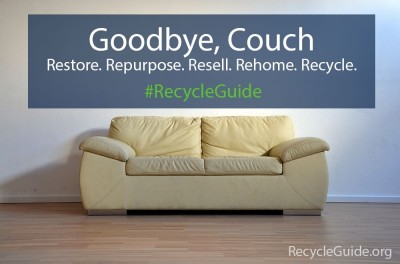
People get rid of furniture for many different reasons. Whether you’re moving, updating your living room, replacing an old bedroom set, downsizing or simply saying goodbye to that old couch you’ve had since college, think twice before tossing it to the curb.
Curbside services vary greatly by area. Depending on your service provider, you may or may not be able to leave furniture and other bulk waste with your household waste. Plus, once those big items are picked up, they will likely end up in the trash, not at a recycling center.
So, what should you do with old furniture?
While a recycling center will receive, break down and process old furniture, there are several other options for discarding large couches, chairs and beds. And, believe it or not, recycling isn’t always the best option. When you reuse an item, you cut down on waste and can often save even more resources than recycling.
Restore it.
Don’t give up on your favorite chair or old dresser just because it is looking a little worn. Repairing furniture can be much easier and more affordable than you might expect. Reupholstering can be as simple as picking up some clearance-price fabric and digging your staple gun out of the garage. Pinterest and YouTube are great places to find ideas and tutorials for simple projects like these.
If you have an antique or more complex chair, couch or other piece you’d like to salvage, a professional upholsterer can handle most fabric repairs. For wooden furniture, you can find everything from special markers to hide scratches and hacks for removing water damage to replacement parts for knobs, legs and drawer sliders.
Repurpose it.
If that dresser no longer needs to be a dresser, perhaps it can find a second life as a bench. End tables can become shelves. Dining room chairs can become planters. The possibilities are endless when it comes to repurposing furniture.
Resell it.
Promote recycling and reusing by having a yard sale. In addition to making some money on your old furniture, it means it will be someone else’s job to move and haul your unwanted furniture. There are also options like local consignment stores, Craigslist, Freecycle.org, Facebook Marketplace and SwipSwap groups.
Rehome it.
There are multiple nonprofit organizations that will gladly accept your unwanted furniture. In most areas, you can find a thrift store associated with a charity. Funds from sales go towards further that organization’s mission. There are also organizations like Pick Up Please and Schedule a Pickup that will pick up furniture from you house. You can also contact local homeless shelters, refugee services, veterans housing and other nonprofits. They are often in need of furniture or can connect you with an individual who is.
When donating to a nonprofit, a receipt should be provided for your in-kind donation. This can be used as a tax write-off when April rolls around.
Recycle it.
Policies vary greatly by area depending on what materials can be processed by your local facility. Save yourself time and frustration. Check with your recycling center to find out what their policies are and what types of furniture they will and won’t accept before you make the trip. You can also check with your city or curbside service provider. They may provide curbside pick up of your furniture. Be sure to verify whether those items are recycled or trashed.
Having a hard time recycling your furniture on your own? You can always hire an eco-friendly junk removal company. Companies like Arwood Site Services provide junk removal service and sort through the junk they remove to ensure anything recyclable is processed separately so it doesn’t end up in a landfill.
